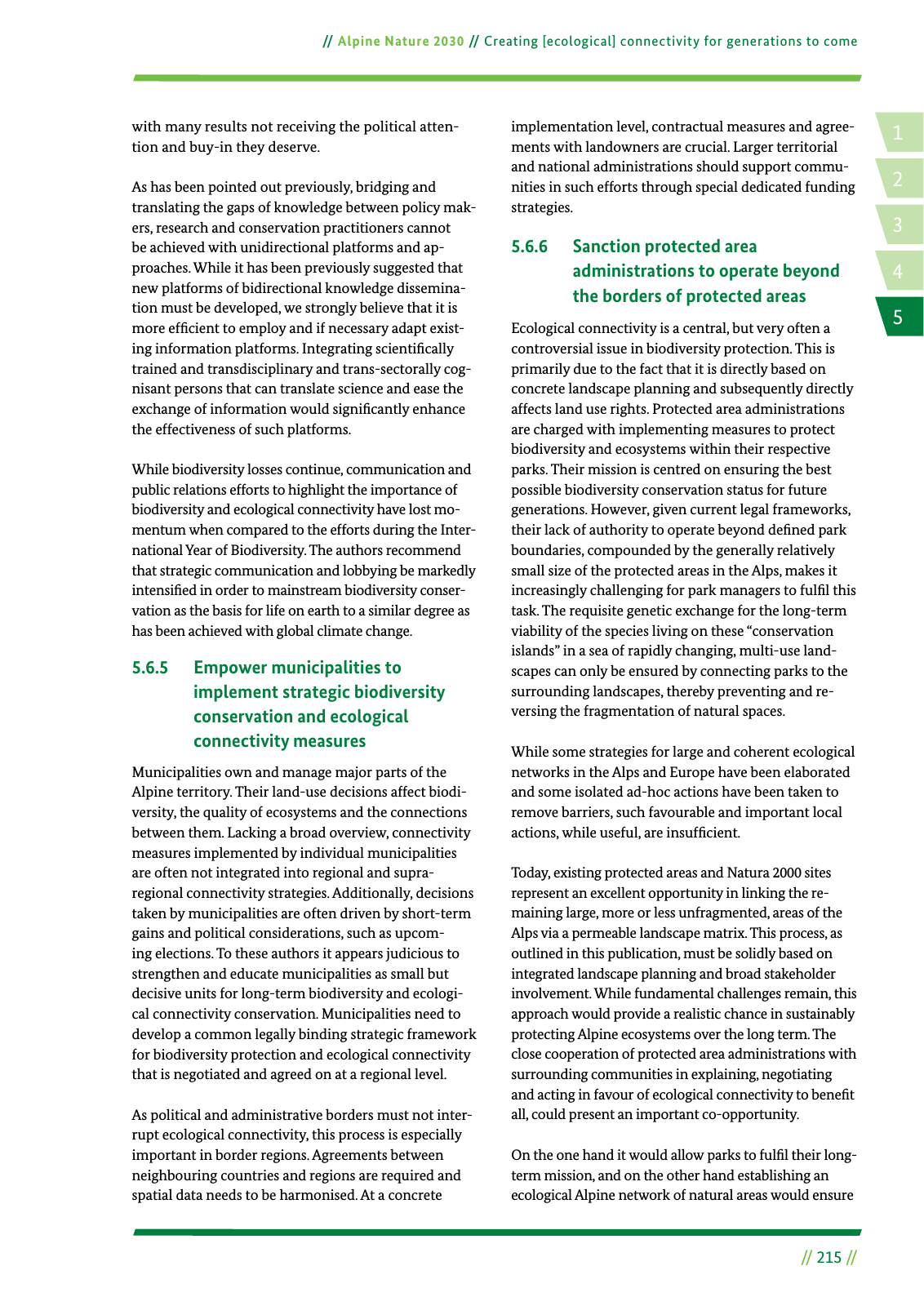14 2 5 3 Alpine Nature 2030 Creating ecological connectivity for generations to come 215 with many results not receiving the political atten tion and buy in they deserve As has been pointed out previously bridging and translating the gaps of knowledge between policy mak ers research and conservation practitioners cannot be achieved with unidirectional platforms and ap proaches While it has been previously suggested that new platforms of bidirectional knowledge dissemina tion must be developed we strongly believe that it is more ef cient to employ and if necessary adapt exist ing information platforms Integrating scienti cally trained and transdisciplinary and trans sectorally cog nisant persons that can translate science and ease the exchange of information would signi cantly enhance the effectiveness of such platforms While biodiversity losses continue communication and public relations efforts to highlight the importance of biodiversity and ecological connectivity have lost mo mentum when compared to the efforts during the Inter national Year of Biodiversity The authors recommend that strategic communication and lobbying be markedly intensi ed in order to mainstream biodiversity conser vation as the basis for life on earth to a similar degree as has been achieved with global climate change 5 6 5 Empower municipalities to implement strategic biodiversity conservation and ecological connectivity measures Municipalities own and manage major parts of the Alpine territory Their land use decisions affect biodi versity the quality of ecosystems and the connections between them Lacking a broad overview connectivity measures implemented by individual municipalities are often not integrated into regional and supra regional connectivity strategies Additionally decisions taken by municipalities are often driven by short term gains and political considerations such as upcom ing elections To these authors it appears judicious to strengthen and educate municipalities as small but decisive units for long term biodiversity and ecologi cal connectivity conservation Municipalities need to develop a common legally binding strategic framework for biodiversity protection and ecological connectivity that is negotiated and agreed on at a regional level As political and administrative borders must not inter rupt ecological connectivity this process is especially important in border regions Agreements between neighbouring countries and regions are required and spatial data needs to be harmonised At a concrete implementation level contractual measures and agree ments with landowners are crucial Larger territorial and national administrations should support commu nities in such efforts through special dedicated funding strategies 5 6 6 Sanction protected area administrations to operate beyond the borders of protected areas Ecological connectivity is a central but very often a controversial issue in biodiversity protection This is primarily due to the fact that it is directly based on concrete landscape planning and subsequently directly affects land use rights Protected area administrations are charged with implementing measures to protect biodiversity and ecosystems within their respective parks Their mission is centred on ensuring the best possible biodiversity conservation status for future generations However given current legal frameworks their lack of authority to operate beyond de ned park boundaries compounded by the generally relatively small size of the protected areas in the Alps makes it increasingly challenging for park managers to ful l this task The requisite genetic exchange for the long term viability of the species living on these conservation islands in a sea of rapidly changing multi use land scapes can only be ensured by connecting parks to the surrounding landscapes thereby preventing and re versing the fragmentation of natural spaces While some strategies for large and coherent ecological networks in the Alps and Europe have been elaborated and some isolated ad hoc actions have been taken to remove barriers such favourable and important local actions while useful are insuf cient Today existing protected areas and Natura 2000 sites represent an excellent opportunity in linking the re maining large more or less unfragmented areas of the Alps via a permeable landscape matrix This process as outlined in this publication must be solidly based on integrated landscape planning and broad stakeholder involvement While fundamental challenges remain this approach would provide a realistic chance in sustainably protecting Alpine ecosystems over the long term The close cooperation of protected area administrations with surrounding communities in explaining negotiating and acting in favour of ecological connectivity to bene t all could present an important co opportunity On the one hand it would allow parks to ful l their long term mission and on the other hand establishing an ecological Alpine network of natural areas would ensure

Hinweis: Dies ist eine maschinenlesbare No-Flash Ansicht.
Klicken Sie hier um zur Online-Version zu gelangen.
Klicken Sie hier um zur Online-Version zu gelangen.